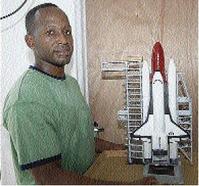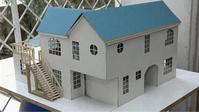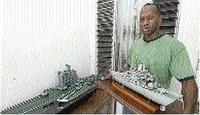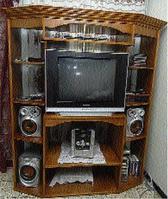Avia Collinder, Outlook Writer
The space shuttle appears ready for flight

Miniature homes are models used by house-holders to show builders exactly what they want. This house was created by Steve Topper according to the specifications of a client.
Steve Topper, 36-year-old factory worker, amazed his colleagues when he first completed a miniature model of a warship over a decade ago. It looked so realistic that, among the many expressions of amazement was the statement, "You are wasting your talent."
There was nobody more surprised than Topper himself who, until then, had lived a very ordinary and, according to him, unremarkable life.
Topper, one of three boys and four girls to Mavis Derby and Rupert Topper, was until that fateful day in 1994 a machine operator at a Kingston factory.
Topper relates the way it happened.
"In 1994 I was on the job and, having some free time on my hands, I didn't want to do a lot of idle talk with my co-workers, so I just sat by myself and used my hand to turn fashion, so to speak."
Using a dressmaker's scissors and thin aluminium, he started work on a battleship which he had seen on television. Seven months later - working only during his lunchtime - the warship - standing two feet long by six inches in width - was completed.
Topper did not begin by doodling on paper.
memory
Instead, he worked 100 per cent from memory, admitting today that the vessel was one he had often seen on Discovery Channel on cable television.
He says, "I always watched documentaries and Discovery Channel, and I was always fascinated by those kind of machines."
When it was completed, so realistic was the craft that he was encouraged by his friends to turn a new page in his life. He began making miniatures, the technical details of which are so lifelike that all who see them frequently comment in amazement.
Topper reflects, "When they saw what I could do, everybody thought that I was wasting time at my workplace. They were saying that I should go off and do a little business. People thought it was something good."
His next project was another ship - this time an aircraft carrier - which was larger and more detailed than the first battleship.
Next was a space shuttle modelled off the one in the Columbia Space project. He then moved on to making miniature houses.
For a man who has no training in carpentry or architecture, the details on each dwelling are surprising well proportioned and aesthetically pleasing.
Topper explains, "My confidence grew."
He has ventured into making furniture as well, and this, along with the house miniatures, have been a source of income.
house model
The artist recalls, "I was here making a little house model and a Henkel sales representative came and saw me doing it. He wanted one. When he took it back to his workplace, a lady there ordered one. From there people started knowing what I do."
The models are now being used as guides in construction.
In Portmore, one of his neighbours wanted to know what he could do to improve his property. The friends sat together and made an outline on paper and, from the drawing, Topper made a miniature house. When it was completed the neighbour stated "That is just what I wanted."
"He is going ahead with that model to use as a guide for construction," Topper boasts.
Currently, the machinist and artist is working on some entertainment stands.
He states, "I am looking in the direction of starting something small in the backyard and growing from there. I could do the miniatures for sale."
The father of one child, a daughter, Topper, who was recently promoted to his company's maintenance department, says it is a challenge to juggle his day job with his dream machines and models.
But, he loves everything he creates and only wants to do as much as possible for as long as he can.

Steve displays a completed seacraft.
The entertainment centre was crafted by Topper. photos by Ian Allen/Staff Photographer

